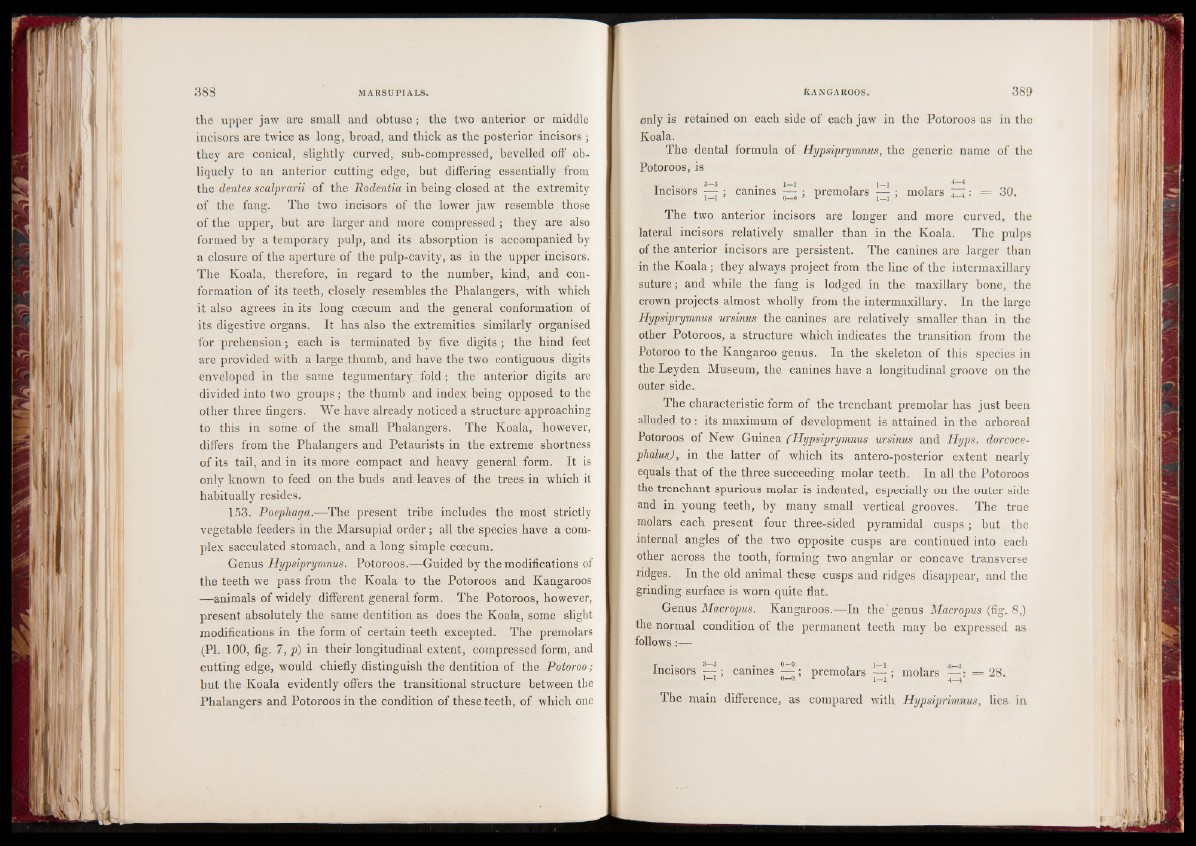
the upper jaw are small and obtuse; the two anterior or middle
incisors are twice as long, broad, and thick as the posterior incisors ;
they are conical, slightly curved, sub-compressed, bevelled off obliquely
to an anterior cutting edge, but differing essentially from
the dentes scalprarii of the Rodentia in being closed at the extremity
of the fang. The two incisors of the lower jaw resemble those
of the upper, but are larger and more compressed ; they are also
formed by a temporary pulp, and its absorption is accompanied by
a closure of the aperture of the pulp-cavity, as in the upper incisors.
The Koala, therefore, in regard to the number, kind, and conformation
of its teeth, closely resembles the Phalangers, with which
it also agrees in its long coecum and the general conformation of
its digestive organs. It has also the extremities similarly organised
for prehension; each is terminated by five digits ; the hind feet
are provided with a large thumb, and have the two contiguous digits
enveloped in the same tegumentary fold; the anterior digits are
divided into two groups ; the thumb and index being opposed to the
other three fingers. We have already noticed a structure approaching
to this in some of the small Phalangers. The Koala, however,
differs from the Phalangers and Petaurists in the extreme shortness
of its tail, and in its more compact and heavy general form. It is
only known to feed on the buds and leaves of the trees in which it
habitually resides.
153. Poephaga.—'The present tribe includes the most strictly
vegetable feeders in the Marsupial order; all the species have a complex
sacculated stomach, and a long simple coecum.
Genus Hypsiprymnus. Potoroos.—Guided by the modifications of
the teeth we pass from the Koala to the Potoroos and Kangaroos
—animals of widely different general form. The Potoroos, however,
present absolutely the same dentition as does the Koala, some slight
modifications in the form of certain teeth excepted. The premolars
(PI. 100, fig. 7, p) in their longitudinal extent, compressed form, and
cutting edge, would chiefly distinguish the dentition of the Potoroo;
but the Koala evidently offers the transitional structure between the
Phalangers and Potoroos in the condition of these teeth, of which one
only is retained on each side of each jaw in the Potoroos as in the
Koala.
The dental formula of Hypsiprymnus, the generic name of the
Potoroos, is
T Inci. sors 3—-3 .; cani _iin es — 1—1 ; premo4—la4rs — ; molars ZH: = 30.
The two anterior incisors are longer and more curved, the
lateral incisors relatively smaller than in the Koala. The pulps
of the anterior incisors are persistent. The canines are larger than
in the Koala; they always project from the line of the intermaxillary
suture; and while the fang is lodged in the maxillary bone, the
crown projects almost wholly from the intermaxillary. In the large
Hypsiprymnus ursinus the canines are relatively smaller than in the
other Potoroos, a structure which indicates the transition from the
Potoroo to the Kangaroo genus. In the skeleton of this species in
the Leyden Museum, the canines have a longitudinal groove on the
outer side.
The characteristic form of the trenchant premolar has just been
alluded to : its maximum of development is attained in the arboreal
Potoroos of New Guinea (Hypsiprymnus ursinus and Hyps, dorcoce-
phalusj, in the latter of which its antero-posterior extent nearly
equals that of the three succeeding molar teeth. In all the Potoroos
the trenchant spurious molar is indented, especially on the outer side
and in young teeth, by many small vertical grooves. The true
molars each present four three-sided pyramidal cusps; but the
internal angles of the two opposite cusps are continued into each
other across the tooth, forming two angular or concave transverse
ridges. In the old animal these cusps and ridges disappear, and the
grinding surface is worn quite flat.
Genus Macropus. Kangaroos.—In the genus Macropus (fig. 8,)
the normal condition of the permanent teeth may be expressed as
follows:—
Incisors i1R—I ; canines 0—0, +p remolars 1——L 7 ; molars 4——4 : = 28.
The main difference, as compared with Hypsiprimnus, lies- in